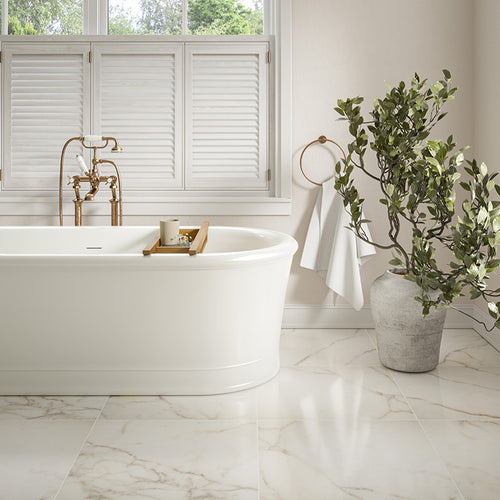Marble vs Marble Effect Tiles
Whether a luxury bathroom or grand entrance hall, the look of marble has an enduring appeal that has been loved for hundreds of years. If you’re looking for kitchen, bathroom or hallway tiles, you may know both real marble tiles and marble effect tiles are available in a variety of styles and sizes, but what is the difference? In this guide we’ll look at marble tiles vs marble effect tiles and unpack the key differences, helping you decide which may be best for your own home.

What is the difference between marble and marble effect?
The essential main difference between marble and marble effect tiles is the material itself. Marble is a naturally occurring material that is quarried from the earth. A marble effect tile is a man-made material, usually porcelain, and is made to replicate the look of real marble. Both have many benefits, as well as things to consider.
Why choose marble tiles?
There is an unmatched individuality and beauty to marble tiles that captures the admiration of many, with homeowners and interior designers choosing marble for bathrooms, hallways and other areas. Natural marble is available in a variety of hues, thicknesses and formats, as well as different characteristics such as veining, patterning and quartzite detailing. All of these features and the depth and translucency of genuine marble make it a premium choice that is an investment for any home – a truly timeless option.
When choosing marble tiles, it is worth considering that the tiles need sealing, with resealing required every few years. A level of care and maintenance is also needed as marble is porous and sensitive to acidic substances such as lemon juice, wine or harsh acidic cleaners. Genuine marble tiles tend to be more expensive than other tile alternatives, although it is recognised as a material that will increase a property’s value.
Marble effect tiles are typically made of porcelain. A porcelain tile is made of a combination of kaolin clay, finely ground sand and feldspar. The clay mixture is fired to an extremely high temperature, resulting in a very dense tile that benefits from a low water absorption rate. The low porosity of marble effect makes it a popular choice as it doesn’t need sealing and is resistant to staining, particularly for bathrooms with walk in showers or wet rooms. The cost of marble effect porcelain tends to be much less than real marble and with constant technological advancements, the variety of designs, colours, sizes and finishes available is vast. If you’re looking for a tile with a little more consistency, then porcelain marble look tiles are perfect for this as they are designed with a certain number of prints.
When choosing marble effect tiles it is worth considering that whilst they are extremely realistic, they are still imitations and may not have the same depth and natural beauty as genuine marble. As mentioned, there are a number of prints per product and although they are designed to mimic natural marble, there is a pattern repetition in marble effect tiles and not every tile will be entirely unique.
Real marble is one of the finest materials available as tiles and is a natural material quarried from the earth. Fake marble or ‘cultured’ marble is made to look like real marble, but is man-made with small marble debris, stone powder, quartz, sand, plastic and acrylic glue. You can often tell if a marble is real by looking at the underneath surface of a tile - fake marble will show little holes where pockets of air popped from the mixing of plastic resin. Real marble will have natural dents. The surface of a marble tile will also a depth and translucency that only comes with genuine marble, whereas fake marble may look ‘flat’ in detail.


Do you need to seal marble tiles?
As real marble is a natural material, it is porous and will absorb any water or spills left on the surface. With this in mind, it is important to seal natural marble tiles which provides a protective barrier against water and staining. Marble effect tiles do not need sealing as they are made of porcelain or ceramic which has a strong glaze on the surface, with a low water absorption rate and resistant to staining.
Can you use marble for bathroom tiles?
Yes! Real marble has been used for centuries as tiles, thanks to its dense characteristics and practicality, as well as offering a timeless tile for the wall or floor of a bathroom. As mentioned, real marble will need sealing and require more maintenance. Marble effect tiles are also popular as bathroom tiles because of their low water absorption rate and ease of keeping clean. Both marble and marble effect are perfectly suitable for bathroom tiles.
Can you use marble for kitchen tiles?
Similarly to bathroom tiles, marble and marble effect tiles are wonderful options for a kitchen, giving the ultimate opulent feel to a kitchen space. Natural marble tiles have been used for hundreds of years in kitchens as a durable floor covering. It is worth considering the maintenance of real marble and the need to seal the tiles. Now more than ever, marble effect tiles are popular for kitchens as they are high traffic areas and porcelain does not need sealing and is near enough stain resistant. Both marble and marble effect are perfectly suitable for kitchen tiles.
Faux marble vs real marble – which should I choose?
Having learnt the difference between marble and marble effect tiles, you may be asking ‘which should I choose’. There is no right or wrong decision in choosing faux marble effect or real marble. Your choice between the two should be based on which you prefer, budget, and intended use of the tiles. Marble effect tiles provide an affordable option to replicate the beauty of marble without the high costs and maintenance, whereas real marble tiles offer timeless, unrivalled beauty and lasting value.











